'Crash course' on COVID cases benefits residents less experienced with thoracic CT
Offering radiology residents a “crash course” in assessing high resolution computed tomography (HRCT) scans can improve reader accuracy and throughput in scenarios similar to those that occurred during the onset of COVID.
The ability of HRCT-naïve radiologists to achieve high overall reader agreement with chest-devoted radiologists (CR) is especially beneficial in situations when volumes are high while staffing is in question. This has been evident throughout the duration of the pandemic, authors of a new paper published in Clinical Imaging recently explained [1].
“Not surprisingly, chest HRCT is a highly requested examination in the current scenario and has been even more frequently requested at the beginning of the pandemic and during subsequent waves,” corresponding author Lorenzo Cereser of the University of Udine in Italy and co-authors wrote. “Within this framework, many non-thoracic radiologists have been called to report a high burden of HRCT examinations while having limited or no subspecialty skills and, in turn, examining unusual, unprecedented HRCT findings.”
The authors suggested that since COVID presents a broad spectrum of manifestations, it can be challenging for residents and radiologists with less experience in thoracic imaging to accurately assess chest CTs of patients presenting with symptoms of the virus. In turn, this presents an increased risk of adverse patient outcomes.
The experts hypothesized that an HRCT-based “crash course” on COVID cases might improve inter-reader agreement between less experienced residents and chest-devoted radiologists. The course included the cases of 150 patients who underwent HRCT for COVID pneumonia between November 2020 and January 2021. It included a ten-day-long “training phase” when residents were presented 100/150 cases and given reports as feedback, and a two-day-long “test phase” when they were asked to interpret 50/150 cases without feedback.
Following the course, the experts observed nearly perfect agreement between the two groups. For consolidation, crazy paving pattern and pulmonary artery diameter, agreement was noted to range from substantial to good-to-excellent.
“We assumed that non-subspecialty radiologists' role would reasonably consist of replying to key clinical questions rather than providing refined judgment of subtler findings,” the authors wrote. “In this light, we aimed primarily to evaluate whether inexperienced readers could reliably assess lung disease extent, as this feature was shown to predict severe clinical outcomes in previous coronavirus-related epidemics, the current COVID-19 pandemic and pulmonary infections in general.”
The authors suggested that similar crash courses could be deployed in situations where a mass influx of illness spreads, such as the COVID pandemic, that puts a heavy burden on emergency departments.

